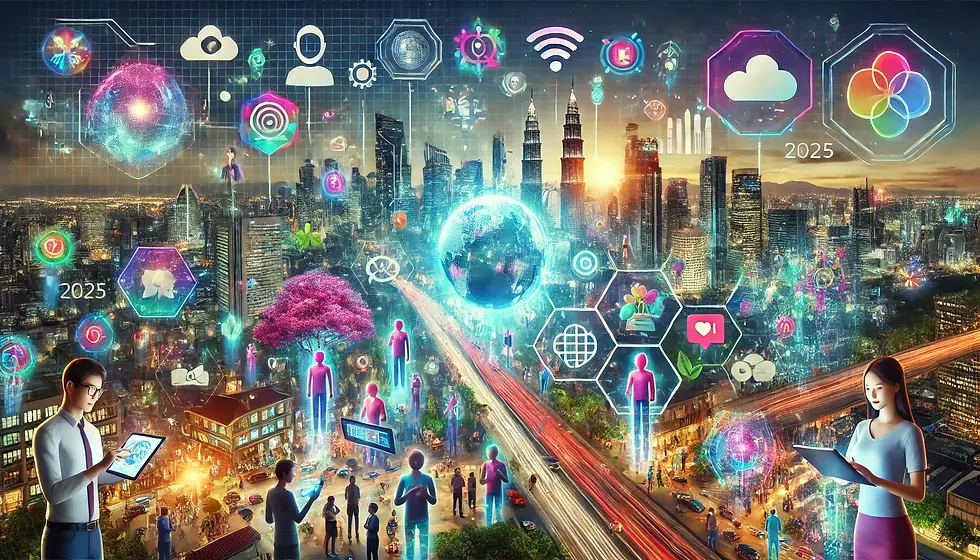The Evolution of PR Strategies: Insights for Modern Agencies
- Saggirio Communications
- Dec 2, 2024
- 3 min read
Updated: Dec 9, 2024
Introduction
In an era defined by rapid technological advancements and shifting consumer expectations, public relations (PR) agencies must navigate an increasingly complex landscape. From startups to industry giants, success hinges on understanding and leveraging emerging trends in digital engagement, data analytics, and cross-channel strategies. Drawing on research from credible sources, this article unpacks the critical drivers shaping PR strategies in 2024 and beyond.
1. Digital Transformation: Beyond Social Media
PR agencies must prioritize integrating advanced analytics, generative AI, and multi-platform content strategies to meet client needs. Companies embracing these technologies report increased engagement and better ROI compared to traditional methods. Additionally, McKinsey highlights the growing adoption of generative AI for crafting targeted messaging and predictive audience insights, with a sevenfold increase in investment from 2022 to 2023. Digital transformation is no longer optional for PR agencies. The integration of AI and analytics provides clear advantages in terms of targeting, efficiency, and ROI. Agencies that fail to embrace these technologies risk falling behind in a landscape where digital-first strategies are paramount.
2. Data-Driven Personalization as a Competitive Edge
Salesforce’s report reveals that 73% of marketers say personalized customer interactions foster stronger relationships. This aligns with recent research that campaigns using tailored content see a 21% increase in sales conversions. These insights suggest that personalization will remain a cornerstone of effective PR, with tools like AI enabling real-time customization at scale. Personalization is a powerful tool for enhancing customer relationships and boosting PR campaign performance. Agencies must invest in tools that allow for real-time data collection and analysis to create dynamic, individualized content that resonates with specific audience segments
3. Sustainability and Ethical Messaging
Deloitte's analysis shows that close to one in three (30%) of consumers prefer brands that demonstrate ethical practices, including sustainable sourcing and transparency. Forrester research corroborates this, noting that businesses prioritizing Environmental, Social, and Governance (ESG) messaging outperform competitors in brand trust by 18%. PR agencies are thus advised to weave sustainability narratives authentically into their client strategies. With consumers increasingly demanding ethical transparency, PR agencies must ensure that sustainability is not just a buzzword but an authentic part of the brand narrative. This shift not only aligns with consumer values but also improves brand perception and loyalty.
4. The Role of Hybrid Experiences
The pandemic accelerated hybrid event adoption, blending virtual and in-person interactions. Recent research highlights that hybrid experiences are here to stay, with 42% of surveyed companies planning to increase investment in hybrid PR campaigns over the next three years. These formats allow PR agencies to reach global audiences while maintaining personalized touchpoints. Hybrid events offer a unique opportunity for PR agencies to expand their reach and engagement. By combining virtual and physical elements, agencies can cater to a global audience while maintaining the intimacy of in-person interactions. As hybrid models continue to grow, agencies that embrace this format will stand out in a crowded marketplace.
5. Cross-Industry Collaboration: A Strategic Imperative
We need to emphasizes the value of cross-industry collaborations, particularly between tech firms and traditional brands. For instance, partnerships in augmented reality (AR) and immersive storytelling are reshaping consumer engagement. Agencies that facilitate such collaborations can drive innovation and amplify campaign impact. PR agencies should actively seek out strategic partnerships across industries, particularly with tech companies, to enhance the scope and impact of their campaigns. These collaborations can result in cutting-edge, interactive experiences that capture attention and engage consumers in new ways.
6. Measuring ROI: From Impressions to Impact
We should stresses the importance of moving beyond vanity metrics like impressions to measure tangible outcomes, such as lead conversions and customer loyalty. PR agencies are increasingly adopting customer journey analytics to tie campaign performance to bottom-line results effectively. Moving beyond traditional PR metrics to focus on ROI will be essential for demonstrating the value of campaigns. Agencies that implement advanced analytics and customer journey tracking can better quantify their impact, leading to more effective and trusted campaigns.
Conclusion
The landscape of PR in 2024 is defined by digital innovation, personalization, ethical engagement, and data-driven insights. Agencies that effectively integrate AI and analytics, prioritize sustainability, and adopt hybrid models will stay ahead of the curve. Furthermore, a focus on cross-industry collaborations and measurable ROI will differentiate the leaders from the followers in the PR world. By combining these elements, PR agencies can build strong, enduring relationships with both their clients and audiences, setting the stage for success in the evolving market.
For deeper insights:


Comments